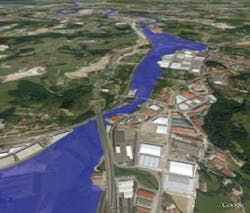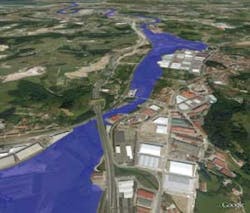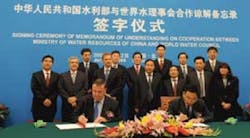By Cory Johnson and David Pernitsky
The water treatment industry continues to work toward higher finished water quality. Regulations such as the surface water treatment rules and disinfection by-product rules, pressure from consumers and internal goals set at the utility create a need for optimizing existing treatment systems.
In addition to pressures to improve water quality, utilities are also motivated to optimize to reduce operational costs at treatment plants. Optimizing treatment system efficiency can reduce energy usage at plants. Optimization also can result in reduced chemical coagulant dosages, which not only has the potential benefit of reducing chemical usage, but also coagulant sludge generation.
Treatment plants must therefore optimize operations to minimize costs while still providing a safe, high quality drinking water. Proper on-line monitoring of treatment processes provides an opportunity to identify areas where operational improvements can be made.
Coagulation
Coagulation parameters, including coagulation pH, coagulant dosage, and mixing, must be right for a water treatment plant to operate correctly. Without proper coagulation, clarification and filtration processes will not function correctly. Filtration typically provides the last physical barrier in a water treatment plant so ensuring filtration has been performed correctly is paramount to providing safe drinking water.
Poor coagulation chemistry often results in:
- High turbidity from clarifiers
- High filtered water turbidity
- Poor filter ripening
- Short filter runs due to earlyturbidity breakthrough
- Elevated levels of aluminum and iron in the finished water
Often, treatment plants treat "flashy" raw waters which can see rapid changes in water quality including organics and turbidity, which changes the overall character of the water and often requires changes in coagulation parameters. In some cases, rapid changes in natural organic matter (NOM) concentrations can occur in the absence of increases in turbidity, and this organic matter can have a high coagulant demand (Pernitsky and Edzwald 2006). The faster a plant can react to these changes, the less likely the plant will experience an upset in treatment.
Additionally, new high rate clarification technologies operate with lower foot prints and higher loading rates. Upsets in treatment can occur more rapidly and therefore must be closely monitored.
Monitoring
Continuous monitoring should be performed at various points in the process to observe how the treatment process is performing. Monitoring organic levels, solids and turbidity levels, charge, and pH can help guide treatment decisions. Monitoring of a typical, conventional treatment plant could include:
- Raw water. Knowing pH, natural organic matter levels, and suspended solids levels in the raw water as well as the charge nature of the water helps guide coagulant dosing decisions.
- Coagulated water. When using particle charge of the water as an indicator of proper coagulation, the coagulated water should be monitored. In addition, the pH should be monitored to verify the correct coagulation pH has been achieved.
- Clarified water. Clarified turbidity levels as well as organics levels should be monitored to determine the effectiveness of the coagulation and clarification process.
- Filtered Water. Filtered water solids parameters including turbidity and particle counts provide an indication of process effectiveness in removing particles. Filter head loss also provides an indication of clarifier performance and can provide insight to filter conditioning, clarifier performance and coagulant/polymer dosing.
Particles
Monitoring particle removal through the process typically means turbidity and/or particle count monitoring. Monitoring of turbidity and particle counts on the raw, clarified, and finished waters provides an assessment of particle removal through the system.
Turbidity Monitors
Turbidimeters provide an indirect measure of the amount of particles in water, based on the light scattering characteristics of the particles in solution. The light scatter depends on the wavelength of the incident light, the number and geometry of the photo detectors in the instrument, and the number, size, shape, and refractive properties of the particles in solution. For individual water supplies, turbidity measurements can be correlated to total suspended solids which reports in milligrams of solids per liter of solution.
Turbidimeters can typically detect particles as small as 0.01 microns if they are present in sufficient number. A turbidimeter's detection limit depends on the wavelength of the light source and the sensitivity of the photodetector(s) used in the turbidimeter to low levels of scattered light. Typical turbidimeters have a detection limit of approximately 0.02 NTU, although turbidimeters with laser light sources and sensitive photodetectors are capable of lower detection limits (Sadar 1999). Turbidity measurements are universal in water treatment plants as the instrumentation is simple and robust, the measurement is accepted by regulatory agencies, and low filtered water turbidity has been shown to correlate to low levels of pathogens in treated water.
Particle Counters
Unlike turbidimeters, particle counters count and size individual particles in a water sample, rather than the characteristics of the bulk solution. Typical particle counters can count and size individual particles as small as 1 to 2-microns in diameter. Results are reported as a number of particles per milliliter for various user-selected particle size ranges or "bins."
Because particle counters detect individual particles, they can enumerate much lower concentrations of particles than a turbidimeter can. They are best suited for measurements of filtered water, where the number of particles is low. The low concentration detection limit of particle counters often allows filter particle breakthrough to be detected earlier than it would be with a turbidimeter. This is the reason why they are so useful for filter optimization.
For samples in which there are large numbers of particles, particle counters can experience coincidence or over-concentration errors. This occurs when two smaller particles pass the sensor together and appear as one larger particle. When this occurs, the instrument cannot distinguish between individual particles, which results in particles being binned and counted inaccurately. Due to coincidence, particle counter readings from raw and clarified water particle counters should be scrutinized.
Sometimes particle counters and turbidimeters see things differently.
The particle distribution in a natural surface water typically follows a power law (1/d3) as Figure 1 suggests. For example, if a water sample has one 10 micron particle, theoretically, the sample would be expected to have approximately one thousand 1-micron particles. As the figure illustrates, the number of particles increases sharply for particles 2-microns and smaller. Although particle counters can detect low numbers of particles larger than 2-microns, they are not sensitive to the large numbers of particles smaller than this size. Turbidimeters, on the other hand, can detect particles smaller than 2-microns, but only if they are present in significant numbers.
Generally speaking the instruments complement one another. Turbidity measurements are used to characterize process streams with relatively high concentrations of particles, such as raw and clarified water. Low-level turbidimeters and particle counters are used for filtered and treated water process streams. Particle counters are especially useful in detecting small changes in particle concentration in samples with low absolute numbers of particles, such as filter and membrane filter effluents.
Figure 2 illustrates typical filtered turbidity and particle count data for a granular media filter where the ripening, steady state, and breakthrough of the filter can be clearly seen. As the figure illustrates, the small changes in particle concentration indicating impending filter breakthrough were detected by the particle counter before the turbidimeter.
Figure 3 and 4 summarize data collected during a pilot scale filter run during which alum dosage was increased to affect treatment performance. For this run, the flocculation and sedimentation processes were allowed to come to steady state at an alum dosage of 18.8-mg/L. At 9:20 the alum dose was changed to 25-mg/L. Approximately 1 hr-15 min of time elapsed before the flocculation and sedimentation processes reached a new steady state.
As Figure 3 suggests, following the dosage change, the average settled turbidity decreases from 1.35 NTU to 1.13 NTU. This settled turbidity decrease correlates to a decrease in finished water turbidity.
As Figure 4 illustrates, the filtered turbidity begins to decline after the dose change, yet particles counts do not appear to be significantly changed from the increased alum dosage. The more pronounced decrease in turbidity would suggest a higher level of sub-micron particles were removed after the dose change. While the turbidity data suggests a higher water quality was produced, the minimal change in particle counts could suggest that the 30 percent increase in alum was not justified.
Charge
Most particles in natural waters have a negative charge at their surface that makes them repel each other and remain stable in the water column. Coagulants are added to reduce these negative charges sufficiently so that the particles can agglomerate together into larger aggregates that can be removed by clarification and filtration.
Sand and anthracite particles in granular media filters also have a negative surface charge. Particles entering these filters need to be near-neutral in surface charge so that electro-static repulsions are minimized and particles can adhere to the filter media surface. Similarly, natural organic matter molecules have negatively charged functional groups. The negative charge demand of the NOM must also be neutralized by the coagulant before settleable and/or filterable floc particles are produced.
In a typical WTP, operators rely on surrogate measures, such as jar-test turbidity, UV absorbance or total organic carbon (TOC) removal, or filter turbidity and ripening time to estimate if floc particles are near-neutrally charged. Because effective clarification and filtration depend on floc particle charge, several instruments have been developed to measure particle charge.
Streaming Current
Streaming current instruments (SCI) provide a relative measure of particle charge, and changes in streaming current are used for process control. In a typical SCI, a water sample enters a sample chamber with a reciprocating piston inside a cylinder. Charged particles in the water attach to the surfaces of the piston and cylinder, and their relative motion cause the generation of a small electric current. This current is amplified and processed, and is displayed as the streaming current. The addition of positively charged coagulants to the raw water causes the streaming current to increase, while increases in particle number or NOM concentrations will reduce the streaming current.
The SCI set point is determined by finding the coagulant dose that results in a high-quality finished water and a stable, well-operating process. Essentially, the streaming current corresponding to optimum coagulation conditions becomes the benchmark for plant operation. For example, if raw water TOC increases, an online SCI will show a decrease in streaming current, indicating that coagulant dose should be increased.
Because streaming current instruments (SCIs) measure changes in particle charge, they are most sensitive under charge neutralization conditions. These conditions typically occur when positively charged coagulant species exist: pH less than 7 for aluminum coagulants (Pernitsky and Edzwald 2000), pH less than 6 for iron coagulants (Amirtharajah and O'Melia 1990), and higher pH when cationic polymers are used. For coagulation at pH less than 7, SCIs have been found to respond rapidly to minor changes in coagulant dose and raw water characteristics; at higher pH, SCI response can be sluggish with decreased sensitivity. Changes in pH or the addition of oxidants will also affect streaming current.
Zeta Potential
The surface charge of a particle can be determined directly by measuring the velocity of the particle in the presence of an electric field of known strength (the electrophoretic mobility) and from this, using established colloid chemistry principles to calculate the "zeta potential." Benchtop zeta potential analyzers provide an absolute measure of particle charge, rather than the relative measure provided by SCIs. Zeta potential analyzers represent the best available analytical technology for optimizing the coagulation of difficult to treat waters (Pernitsky et.al. 2010). Optimum coagulation conditions are determined by adding coagulant chemicals to raw water samples in a manner similar to jar testing, and then transferring the coagulated water to the zeta potential instrument, where the charge is determined. It has been shown that zeta potentials between -8 mV and +5 mV correspond to good clarification and filtration in WTPs (Pernitsky et.al. 2010). Zeta potential instruments are not subject to the same interferences as SCIs, and are simple to use for WTP operators.
Organics
Many facilities monitor organic levels during the process as an indication of coagulation efficiency as well as to guide coagulant dosing decisions. In addition, finished water organic levels can be used to estimate disinfection by-product formation potential once a database of disinfection by-product data has been developed.
While organic monitoring is not as common as charge and particle monitoring, it provides additional data for operations staff to use when making treatment decisions. Typically, organic level monitoring is done with either UV254 or total organic carbon (TOC) monitoring. While TOC provides a direct measure of organic levels, UV254 provides an indirect measure of TOC. By developing a database comparing UV254 to TOC, correlations can provide a reasonable estimate of TOC and TOC removal through on-line UV254 monitoring of the raw and clarified water, respectively. Note, UV254/TOC correlations must be made for each specific water supply. UV254 measurements are simpler and the online instrumentation is less expensive and requires less maintenance, making UV254 measurements the preferred choice for many WTPs.
Summary
Monitoring of conventional treatment plants provides an opportunity for operations staff to improve water quality and optimize treatment systems to meet the utility's internal goals as well as regulations. However, the term "optimum" varies from one utility to the next. Utilities must often balance operational costs with the need to strive for ever improving water quality.
Monitoring throughout the treatment process, from the raw water, to the coagulated and clarified water, to the finished water tells operations staff how the plant is operating and if changes need to be made. Operations staff must be vigilant in making sure the coagulation process is working properly as poor coagulation can significantly affect downstream processes.
Many surrogates exist for organic levels, particles, and charge but plant specific and water supply specific databases must be developed to make better use of the surrogate data and optimize treatment.
WW
About the Authors: Cory Johnson, P.E., is Drinking Water Technology Leader for CH2M HILL's Eastern US Region. He specializes in conventional water treatment plant and membrane plant design, energy and process optimization, and pilot investigations. Johnson is based in Deerfield Beach, FL. Dave Pernitsky is CH2M HILL's Drinking Water Technology Leader for the Canadian region. He specializes in water treatment plant process design, optimization, and troubleshooting. Pernitsky is based in Calgary.
More WaterWorld Current Issue Articles
More WaterWorld Archives Issue Articles







